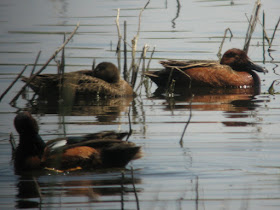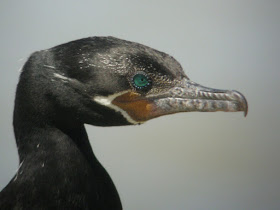 April 24-May 1. The week in New Mexico provided several birding opportunities. Most notable was a day (April 27) spent at Bosque del Apache National Wildlife Refuge located in the Middle Rio Grande Valley about 20 miles south of Socorro. Any birding trip to New Mexico without stopping into the refuge is a significant oversight. The refuge is reknown for its thousands of wintering Sandhill Cranes and Snow Geese. Even though the cranes and geese departed for their northern breeding grounds weeks ago, there was much to be seen as other winter migrants lingered on and new spring arrivals were trickling in.
April 24-May 1. The week in New Mexico provided several birding opportunities. Most notable was a day (April 27) spent at Bosque del Apache National Wildlife Refuge located in the Middle Rio Grande Valley about 20 miles south of Socorro. Any birding trip to New Mexico without stopping into the refuge is a significant oversight. The refuge is reknown for its thousands of wintering Sandhill Cranes and Snow Geese. Even though the cranes and geese departed for their northern breeding grounds weeks ago, there was much to be seen as other winter migrants lingered on and new spring arrivals were trickling in. New Mexico at this time of year is a season of transition as well as contrasts: the thread of riparian woodlands intersecting the northern Chihuahuan desert were the leafing out and daytime temperatures in the Valley were in the low 80s falling into the 40s and 50s during the night. On the other hand, add another 3,000 ft elevation and the temperatures are a comfortable 70s with nights possibly falling to freezing or even below. We were surprised upon rising morning to 27 degrees and snow blanketing the ground. The sugar solution in the hummer feeders was frozen none several Broad-tailed Hummingbirds were actively flying about and checking out the feeders. That was a sight we are definitely not accustomed to seeing in northern New England.
The Bosque, which means woodlands, measures 57,191 acres in size and is comprised of riparian cottonwood bosques, desert scrub and canyons, freshwater impoundments and marshes, and agricultural lands managed by the U. S. Fish and Wildlife Service for a diveristy of wildlife and plant communities. The refuge includes elevations ranging from 4,500 to 6,272 ft above sea level.
The single full day I spent birding the refuge core area (including 15 miles of roads encircling the seasonal and permanent ponds and wetlands) produced 73 species listed below. Many passerine species that I have seen at this time of year on previous visits were missed altogether. But given the size of the refuge, much of it open to birders, and my own time limitations, it is not at all surprising that species went unseen. Digiscoped images of some of my sightings are at the end of this post.
Snow Goose, white morph
Ross's Goose
Canada Goose
Gadwall
American Wigeon
Mallard
Blue-winged Teal
Cinnamon Teal
Northern Shoveler
Northern Pintail
Green-winged Teal
Redhead
Ring-necked Duck
Lesser Scaup
Bufflehead
Common Merganser
Ruddy Duck
Ring-necked Pheasant
Wild Turkey
Gambel's Quail
Pied-billed Grebe
Eared Grebe
Western Grebe
Neotropic Cormorant
Great Blue Heron
Great Egret
Snowy Egret
Cattle Egret
Black-crowned Night-Heron
White-faced Ibis
Turkey Vulture
Osprey
Northern Harrier
Red-tailed Hawk
Peregrine Falcon
Virginia RailAmerican Coot
Killdeer
Black-necked Stilt
American Avocet
Lesser Yellowlegs
Lesser Yellowlegs
Long-billed Dowitcher
Wilson's Phalarope
White-winged Dove
Mourning Dove
Greater Roadrunner
Lesser Nighthawk
Black-chinned Hummingbird
Black Phoebe
Say's Phoebe
Ash-throated Flycatcher
Western Kingbird
Chihuahuan Raven
Tree Swallow
Northern Rough-winged Swallow
Bank Swallow
Cliff Swallow
Barn Swallow
Bushtit
Bewick's Wren
Blue-gray Gnatcatcher
American Robin
Yellow Warbler
Yellow-rumped Warbler, Audubon's and Myrtle subspecies
Summer Tanager
Spotted Towhee
Chipping Sparrow
Lark Sparrow
Dark-eyed Junco, Gray-headed and Pink-sided subspecies
Black-headed Grosbeak
Red-winged Blackbird
Brewer's Blackbird
Bullock's Oriole
House Finch
Fortunately, two white geese, a Snow and a Ross's, had not left for the north and offered close-up side-by-side comparisons. The size difference between the two birds was clearly evident. While the head structure of the Snow Goose had sharply angular features that of the Ross's Goose seemed more akin to a Beatrix Potter illustration: soft, gentle and diminutive. To this observer the so-called "grin patch" of the Snow Goose bill is more sneer-like.
Above photos (top to bottom):
- Male Gambel's Quail sporting characteristic 1950s pompadour.
- Snow Goose.
- Ross's Goose.
- Cinnamon Teal, male and female.
- Redhead, male.
- Eared Grebe.
- Neotropic Comorant in breeding plumage.
- White-faced Ibis.
- American Avocets.
- Black Phoebe.
- Western Kingbird.
- "Audubon's" Yellow-rumped Warbler, male.
- Rising full moon over the Bosque. Note the three dark specks on its face...swallows.













No comments:
Post a Comment